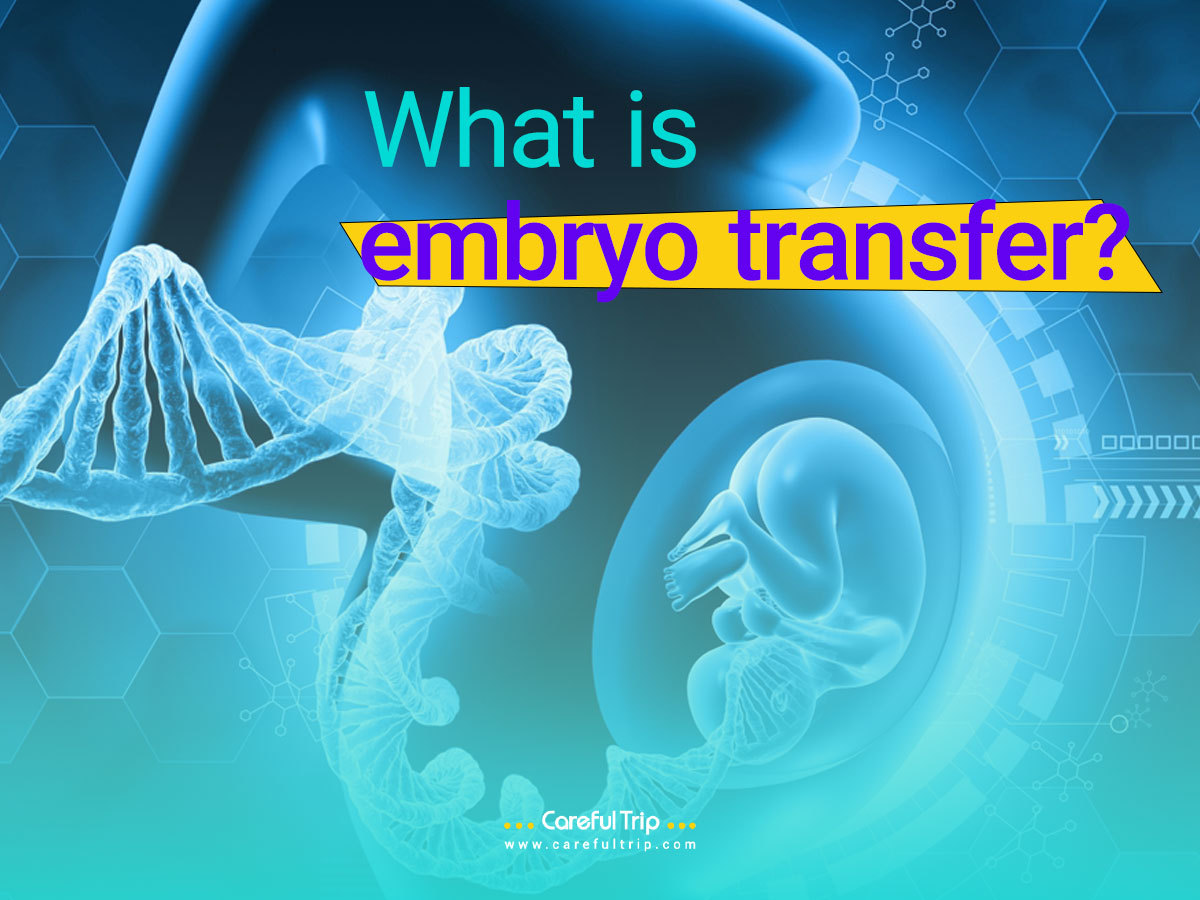Today, in vitro fertilization (IVF) methods help countless couples make their dream of having biological children come true. These methods include many modern approaches, divided into surgical and non-surgical ones, often called Assisted Reproductive Technology (ART). Among modern IVF methods, embryo transfer is one of utmost importance. In embryo transfer, fertilized eggs are placed in the uterus to form a fetus. One or two fertilized eggs from your IVF or ICSI treatment are transferred with a catheter through the cervix into the patient’s uterus to allow implantation to occur.
Surgeons employ strategies and tools to achieve maximum success rates during embryo transfer. Embryo transfer is a meticulously designed and vital phase in the IVF process, being the culmination of fertilization and embryo culture. This step is critical as it directly impacts the success of the entire IVF cycle. Embryo transfer typically occurs after five to six days of embryo culture when the embryos reach the blastocyst stage.
Embryo transfer is among the most common IVF procedures with a high success rate in countries like Iran, where ART is practiced at a high level and affordable prices. But what is the nature of this procedure, and what does it entail?
For more information, read:
A short glance at the Embryo transfer
Embryo transfer is a crucial part of egg planting, a type of IVF (in vitro fertilization). To learn what an embryo transfer is, we need to review the process of a successful IVF. When a candidate undergoes an IVF procedure, the surgeons, in the first step, use particular medicines to stimulate the ovaries to produce wholesome eggs. This activity is crucial in fertility and is considered a giant step. The stages of embryo development include the zygote, cleavage stage, morula, and blastocyst.
Then, these healthy eggs should be drawn from the female’s body and transferred into an IVF laboratory. In this stage, the professionals employ special techniques, like adding the sperm to fertilize the eggs and prepare them for the next step. The physicians may check the in vitro eggs at various times to ensure that they are in the proper process of being fertilized. Once the expected results have been received, another phase begins, namely the embryo transfer. In this stage, experienced doctors transfer a proper quantity of fertilized eggs into the female’s uterus to form a fetus.
For more information, Read:
How is embryo transfer done?
To be more specific, after the surgeons put a suitable amount of embryos (fertilized eggs) in the uterus and examine them with special tools like an ultrasound machine, the embryo tries to attach itself to the wall of the uterus. It starts the process of developing a fetus. Luteal phase support with progesterone is essential to prepare the uterine lining for implantation.
Still, the surgeon’s skill in placing the fertilized eggs is one of the most critical phases of this procedure; that’s why we suggest you undergo embryo transfer in Iran. Many experienced surgeons in this country ensure a delicate IVF with a reasonable success rate.
How long after embryo transfer is implantation?
After the placement, your doctor will examine the fertilized eggs to ensure they are in the proper position and notice that the implantation occurred successfully. The vital sign of turning into this phase is the attachment of an embryo to the wall of the female’s womb. It usually happens around six to ten days after the beginning of the IVF, so it is expected to occur from one to five days after the embryo transfer.
Embryo Transfer Procedure
The embryo transfer procedure is a meticulously orchestrated step in the in vitro fertilization (IVF) process and is essential for achieving a successful pregnancy. This procedure involves transferring the best-quality embryos into the patient’s uterus, typically three to five days after egg retrieval. The timing is critical, as the endometrial lining must be optimally prepared to receive the embryos. Preparation includes hormonal treatments such as estrogen and progesterone to ensure the uterine lining is receptive. The embryos are selected based on their development stage and quality, often graded on a scale that assesses their viability. Some clinics may also use preimplantation genetic testing (PGT) to select embryos free of genetic abnormalities, further increasing the chances of a successful pregnancy.
During the transfer, a thin, soft catheter containing the embryos is gently inserted through the cervix into the uterus under ultrasound guidance, ensuring precise placement. This procedure is usually quick and minimally invasive, causing little to no discomfort for the patient. Post-transfer care involves continued hormonal support to aid implantation and early pregnancy, and patients are often advised to rest briefly following the procedure. Success rates for embryo transfers have improved significantly due to advances in technology and technique, but the outcome depends on multiple factors, including the patient’s age, health, and the quality of the embryos. Thus, embryo transfer is a critical and highly anticipated phase in the IVF process, holding the promise of achieving pregnancy for many hopeful parents.
Embryo Transfer Methods
There are many variations of embryo transfer methods. Nonetheless, the main aim is to increase the chance of pregnancy to the maximum. One common procedure is a fresh embryo transfer. The fresh embryo transfer, at typically day 3 or day 5 post-fertilization, is when the embryos are transferred to the woman’s uterus. This approach is based on the synchronization of the patient’s endometrial lining with the embryos growth.
Another method that has been developed is cryopreserved transferred embryos, also known as Frozen Embryo Transfer (FET). The patients’ embryos are frozen post-fertilization and defrosted before they are transferred into the uterus. This approach supports a more adaptable endometrial preparation time without the hormonal exposure required in the original IVF cycle. Research shows that FET can be equally effective as fresh transfers due to improved endometrial receptivity and decreased risk of ovarian hyperstimulation syndrome (OHSS).
In addition to these methods, alternative techniques can be used. Such as assisted hatching, where a small opening is made in the embryo’s outside coating, the zona pellucida, prior to the transfer. This procedure is believed to help the embryo attach to the uterus more easily, especially if previous IVF cycles have failed or the embryos are from a woman who is over 35 years old and have a tougher, older coating.
Lastly, Blastocyst transfer is a growing technology in embryo transfer. To create blastocysts, embryos are cultured until day five or six, believing the blastocyst implants easier and that the uterine environment has had time to adjust. These methods enhance the transfer of an embryo that is curtailed, detailed evidence-based practice to the individual patient based on specific needs or characteristics.
For more information, read:
How many embryos do you need to get pregnant?
Various factors must be examined before deciding on the number of embryos to be placed in the female’s uterus. The doctor determines the parents’ condition and plans the procedure accordingly. The average number of embryos is between one and two. Elective single embryo transfer (eSET) is recommended to reduce the risk of multiple pregnancies.
Nevertheless, most IVF specialists agree that transferring up to three embryos at once is the best way to maximize a woman’s chances of becoming pregnant. On the other hand, this means you run the possibility of having multiple pregnancies, which increases the dangers to both the baby and the mother.
Are embryo transfers painful?
Most parents would like to know how painful this procedure is. As mentioned before, the surgeons need to remove and puncture the eggs from the female’s ovaries and transfer them into an IVF laboratory for the rest of the process. In this case, the candidates may find the egg-releasing process a little discomforting and experience mild pain after the end of the process. Patients might experience mild cramping after the procedure, but severe pain is uncommon. Also, some bleeding is expected after the egg removal, which will disappear gradually. Besides this, embryo transfer is not painful; The doctor may gently place the required cells into the uterus without discomfort.
When an embryo transfer is needed?
Simply, the embryo transfer or the whole IVF process is required when the natural way of having a child fails. As the specialists and doctors of IVF in Iran say, there are specific situations in which embryo transfer will be needed. So, the medical team prefers to follow the fertilization process using an artificial method that involves embryo transfer. On top of this, there are specific problems that lead to the embryo transfer, such as:
- Genetic disorders: It is recognized that certain genetic conditions can prohibit a woman from becoming pregnant.
- Uterine fibroids: Uterine fibroids are noncancerous growths found on the uterine wall. They have the potential to inhibit the capacity of an egg to implant itself in the uterus, hence preventing conception.
- Damage to Fallopian tubes: The embryos move to the uterus via the fallopian tubes, which connect the ovaries to the fallopian tubes. If the tubes are injured or scarred, fertilized eggs will have difficulty making it to the womb in a healthy manner.
- Ovulation disorders: If ovulation happens infrequently, fewer eggs will be available for adequate fertilization.
- Endometriosis: When uterine tissue implants and grows outside the uterus, it may hurt the functioning of the female reproductive system.
Where should you receive embryo transfer?
The success rate of IVF is one of the crucial factors when choosing a trusted destination for your medical trip. Many aspects are involved in reaching a high success rate; the technology employed for the process, the knowledge and experience of the clinical team, and the medical history of every candidate are a part of them. Remembering that even cutting-edge tools and top hospitals cannot raise the success rate without a good hand is essential. Apart from the success rate, factors like the affordability of the procedures, waiting lists, accommodations, and the care given by the hospital staff play a big role in choosing your IVF destination. Countries like Iran, which is ever-rising in the medical tourism landscape, are ideal places for all these factors, making them one of the best places to visit for an embryo transfer.
All in all, candidates for embryo transfer in Iran will enjoy a reasonable success rate. In Iran, advanced equipment and skilled surgeons are in service to make their best effort and enhance the success rate of the process. The embryo transfer success rate in Iran is above 65 percent in most clinics and hospitals. Still, we suggest you visit a professional and ask them about the expected success rate.
How to receive Embryo Transfer in Iran?
Iran’s affordable fertility care, coupled with its world-class physicians, make it a prime destination for those seeking IVF procedures abroad. Embryo transfer is a common practice in Iran’s fertility clinics, like the excellent MOM Fertility Center. Through the CarefulTrip agency, you can learn about embryo transfer procedures at MOM Fertility Clinic and receive our free consultation. Reach out to us today to make your dream of parenthood a reality.
For more information, read:


